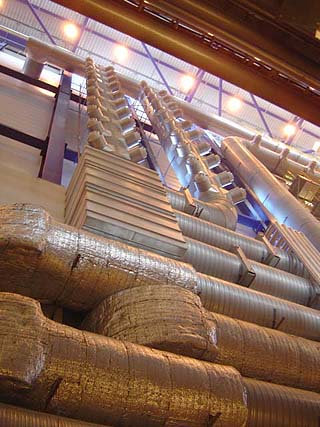|
Subscribe / Renew |
|
|
Contact Us |
|
| ► Subscribe to our Free Weekly Newsletter | |
| home | Welcome, sign in or click here to subscribe. | login |
Environment
| |
June 16, 2004
Alchemy of incineration: from waste to resource
Special to the Journal

Photo courtesy Catherine Hart, VIA Suzuki Architecture
Inside the ultra-modern waste incineration plant in Malmö, Sweden.
|
Simply put, we generate a lot of garbage. In 2001, 20 municipal solid waste landfills accepted more than 9 billion pounds of waste generated by Washington state. Of this amount, 2.3 billion pounds were exported, making it a bigger out-of-state export than apples.
Waste generation is growing at a faster rate than population growth and the Washington State Department of Ecology predicts that both population and waste generation in the state will continue to increase substantially.
There are alternatives. For every three tons of garbage, the new super-efficient incinerator operated by SYSAV in Malmö, Sweden, extracts the equivalent energy of one ton of oil. Nine municipalities, with a total of 500,000 inhabitants, jointly own SYSAV, a regional waste service company serving southern Sweden.
In addition to burning its own wastes, Sweden has become a waste importer. Revenue is generated in two ways: by selling waste incineration services, and by selling the energy and heat produced by incineration. This is the alchemy of waste incineration: Waste = Energy = Revenue.
There are now two waste incineration plants in an industrial area of Malmö, less than five miles from the city center. The new state-of-the-art facility manages some 200,000 tons of combustible household and industrial waste per year in a plant that is spotlessly clean, odor free and architecturally designed.
Energy is produced through combustion as electricity and hot water, and is supplied to the district heating system. Combined with the 1973 waste-to-energy plant still in use, the combined output per year is 1 TWh of energy from 840 million pounds of waste. (TWh is the term for 1 billion KWh or the amount of energy produced by a 114-MW generator over the course of a year.)
Waste is incinerated 24 hours a day, 365 days a year. Most people who look into the 900-centigrade fire find it fascinating. It provides a pretty good idea of what hell would look like.
| How do we compare? | ||||
| Recycling | Incineration | Landfill | Composting | |
| Washington (2001) | 37% | 10%* | 47% | 6% |
| Sweden (2002) | 31% | 40% | 20% (Reduced to 10% in 2004) | 9% |
| * In 2002, the Tacoma waste incineration plant was closed. This plant accounted for 45% of the state's incineration in 2001. | ||||
|
| ||||
After incineration, SYSAV must deal with the remaining waste material, which is called slag. Slag contains large amounts of scrap metal. The scrap metal is sorted with the aid of magnets and the remaining material is used for a variety of purposes, including as a substitute for gravel in road building. What can't be dealt with in any other way goes to the landfill. In Sweden this year, 10 percent of waste ends up in landfills.
Waste incineration produces highly polluted flue gasses. Prior to the gasses leaving the stack, the various pollutants are extracted and either stabilized or converted to a benign substance in a step-by-step process. Dangerous toxins like dioxin, once a significant bi-product of waste incineration, have been reduced substantially and are now close to zero. All the plants in Sweden meet EU standards for dioxin.
Sweden's waste management philosophy is based on the concept of the eco-cycle. Incineration is seen as another form of recycling in which the energy used in the material is recycled rather than the material itself. It is illegal to landfill combustible materials.
The problem with waste incineration is that it is inherently seductive. It's like eating potato chips with olestra, which markets itself as the "no fat cooking oil with full fat flavor." It allows us to indulge in our wasteful habits without guilt. In European conferences on waste management, the debate is frequently over whether to recycle or to incinerate, with both sides claiming that their preferred method is better both environmentally and economically.
This is why there are legitimate concerns about waste incineration even by those who understand that it is a good alternative to landfills, particularly with its energy producing capabilities. It is the easy way out -- the hassle-free solution, which could call into question important efforts at recycling and reuse.
In Sweden, waste incineration is part of an integrated solution that also includes making producers responsible for the disposal and recycling of their products and packaging, general efforts to recycle and reuse, and reclamation of raw materials such as metals and phosphorous.
Waste incineration should be done in addition to reduction, reuse and recycling, not as a substitute for them.
Patricia Chase is with International Sustainable Solutions (www.i-sustain.com). ISS encourages sustainability practices and products by sharing knowledge and helping create market opportunities. Sponsorship of education materials provided by Catapult Community Developers, CH2M Hill, Gregory Broderick Smith Real Estate, Magnusson Klemencic Associates, Nitze Stagen, ZGF Partners and Vulcan Inc.


